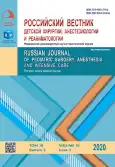Treatment of children with skin and soft tissue defects of distal phalanges of the fingers
- Authors: Berezutskii S.N.1, Pinigin A.G.1
-
Affiliations:
- Far Eastern State Medical University
- Issue: Vol 10, No 3 (2020)
- Pages: 293-298
- Section: Original Study Articles
- URL: https://journals.rcsi.science/2219-4061/article/view/122924
- DOI: https://doi.org/10.17816/psaic687
- ID: 122924
Cite item
Full Text
Abstract
Introduction. This article discusses the relevance of performing organ-preserving operations for traumatic skin and soft tissue defects in children. The author analyzes the traditional types of skin grafting procedures and their application in children. From the authors' point of view, the most acceptable skin grafting method is a displaced island flap on a neurovascular pedicle with direct blood flow.
Materials and methods. The operating technique of lifting a displaced island flap on a neurovascular pedicle with direct blood flow is shown. The features of its implementation, the number of children, and their distribution by groups are shown. From 2016 to 2019, 15 children with traumatic defects of the distal phalanges of the fingers were operated on in the microsurgical Department of the Khabarovsk KKB No. 2 using a displaced neurovascular island flap on the leg with “direct” blood flow. The children ranged in age from four to 14 years. The number of children and the frequency of damage to the right and left hands was approximately the same.
Results. Positive results of using this technique in the Department of Microsurgery of KKB No. 2 are presented. In all cases, it was possible to close the existing defects with the primary closure of the donor defect simultaneously; Sensitivity was preserved in all operated children, and movements in the finger joints were almost complete.
Discussion. This flap method has undeniable advantages, although it is quite time-consuming and requires microsurgical skills, techniques, and appropriate equipment. The proposed skin grafting results are encouraging and satisfying for both doctors and children with parents.
Conclusions. The authors recommend this skin grafting method for traumatic defects of the distal phalanges of the fingers in children.
Keywords
Full Text
##article.viewOnOriginalSite##About the authors
Sergey N. Berezutskii
Far Eastern State Medical University
Author for correspondence.
Email: s79242147010b@yandex.ru
Cand. Sci. (Med.), Head of the Department of traumatology and orthopedics
Russian Federation, KhabarovskAlexey G. Pinigin
Far Eastern State Medical University
Email: nauka@mai.fesmu.ru
Cand. Sci. (Med.), Head of the Department of pediatric surgery, traumatology and orthopedics
Russian Federation, KhabarovskSupplementary files










